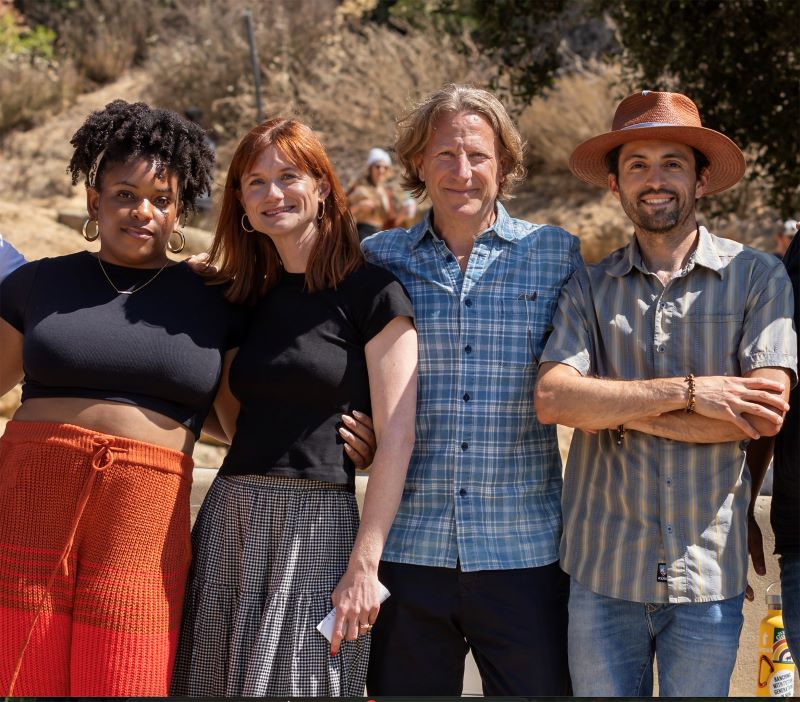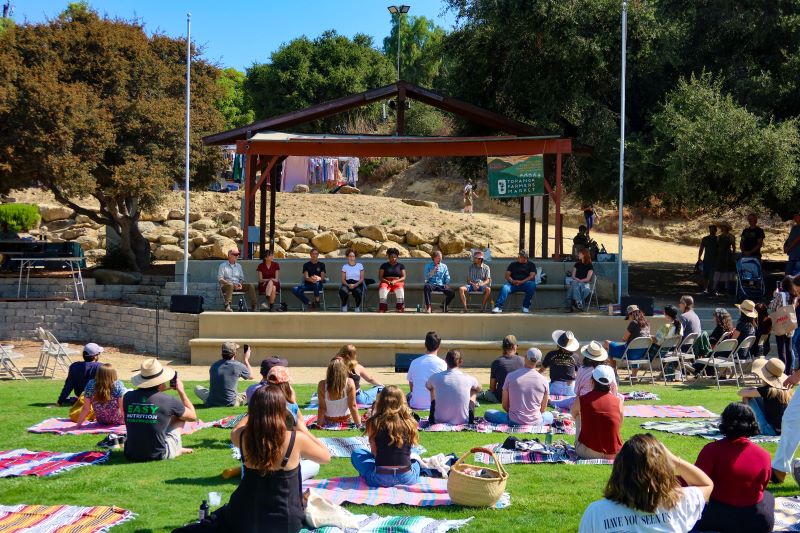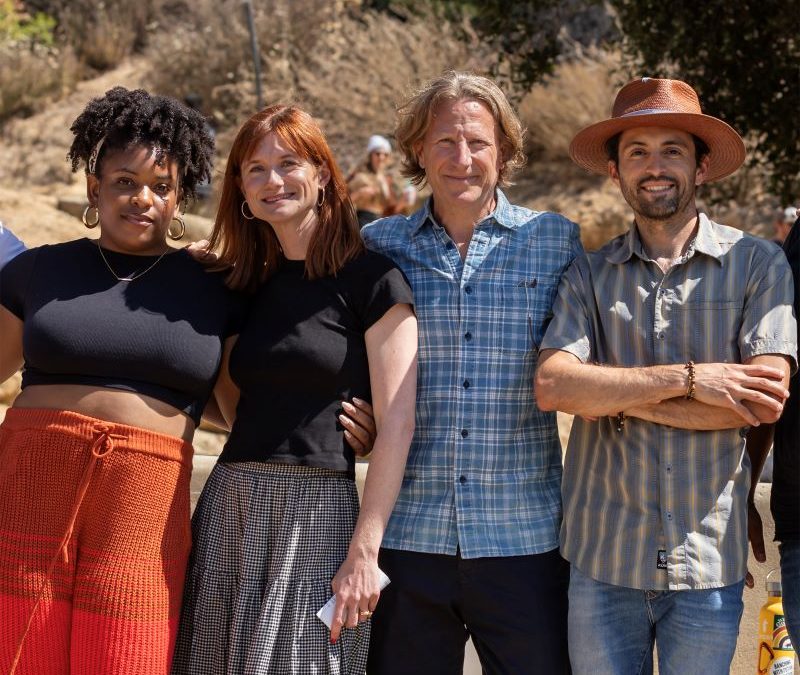
The beginning of September ushered in a heat wave of epic proportion. It was the kind of heat that inspired imagery. As the poet Hilda Doolittle wrote, “Fruit cannot drop through this thick air—fruit cannot fall into heat that presses up and blunts the points of pears and rounds the grapes.”
It was also the kind of heat that endangered crops and livestock. It was the kind of heat that taxed the power grid. It was the kind of heat that wedged itself into conversations about the ethics of environmental citizenship.
The day Topanga lost power, I found myself at The Well Refill, pondering the synchronicity of being stuck in a shop dedicated to eliminating unnecessary packaging waste and lessening clients’ carbon footprints. I was surprised to see English actress and filmmaker Bonnie Wright gracing the cover of a hardback on display. Wright is perhaps best known for her portrayal of the character Ginny Weasley in the Harry Potter films.
I did not know until that moment that Wright is a Santa Monica Mountains resident and tireless environmental activist. Her debut book, Go Gently, was published in 2022 and highlights actionable steps one can take to address climate change. It’s not surprising at all, then, that she moderated an LA Climate Week panel at the Topanga Farmers Market Friday September 13, presiding over speakers ranging from farmers to educators.
The panelists included Mason Hernandez of Perennial Pastures, Olympia Auset of SUPRMARKT, Charles Barth of School of Lunch, Diego Hernandez of Ayala Family Farms, Valeria Velazquez Duenas of LA Food Policy, Molly and John Chester of Apricot Lane Farms, and Evan Harrison of Kiss the Ground. They were there to talk about regenerative farming and the future of the food supply chain.
The first question posed was, how do you imagine a thriving food system? Panelists were quick to agree on a utopian vision: accessible, affordable, clean food for all, grown in a way that nourishes humans and the planet on which we live.
How do we get there? First, remove the word ‘fight’ from climate dialogue; we are not really fighting climate change, rather, we are trying to get to a level of coexistence, living in harmony with nature and each other. That symbiosis is something many indigenous peoples of the world have always been guided by, and the concept of “re-indigenization” is something many growers are embracing.

Wright suggested we examine the common narrative: “We’ve been taught to think, ‘oh I’ve got to go out in nature, to a mountain or a beach or a park to reconnect with myself’, rather than truly believing that we are part of nature.” It changes how you approach the Earth, and perhaps how responsible you feel as its caretaker.
When we stop fighting the forces of nature, we can turn our attention to a food movement based on equity and inclusion. In one of the wealthiest countries in the world, currently there are still many Americans who are food insecure. USDA statistics put the number at 47.4 million in 2023.
According to the nonprofit organization Feeding America, in 2022 49 million people turned to food assistance for extra help. That’s why the LA Food Policy Council took action to get food stamps accepted at all Los Angeles farmers markets.
The Los Angeles City Council unanimously approved the proposal, a big win, considering many lower income households rely on stores they can walk to for groceries. Those stores are often stocked primarily with boxed products with less than optimal nutritional content. Kate Kimmel and Freddi Swanson, co-founders of the new Topanga Farmers Market, are applying to have EBT (electronic benefits transfer, the digital replacement of paper food stamps) accepted at their market as early as next year.
As Olympia Auset succinctly put it, how we relate to one another—and particularly how we relate to women and minorities—is how we will relate to the planet. Do we see ourselves as separate or as part of a whole? When the conversation turns to food equity this is what is meant: the distribution of food in this country is simply not equal. Those who can afford to pay a premium for healthy fresh organic food, do. Those who can’t are left behind. Should nutrition and health be a privilege or a basic human right? Is there a moral responsibility implicit in being a member of the ‘haves’ versus ‘have nots’?
This is one of the questions producers and consumers alike grapple with, desperate for a solution to the long-standing problem. How can farmers make a living growing and selling food that is gentle to the earth and accessible no matter where they live?
“As someone who eats food and lives on the earth, I am very concerned about the issues we are discussing,” Velazquez Duenas said. She works at the intersection of advocacy and policy, for the LA Food Policy Council (LAFPC), the parent organization for a network of over 400 agencies working to get healthy food where it needs to be. Beyond just delivering food to places like Skid Row, LAFPC’s mission includes fostering economic growth and development in the communities they serve.
Coexisting with each other and the land, and making sure food and opportunity are distributed equally, are foremost guiding principles. Even if we learn to get along with each other and the planet, and play fairly, the land is still in need of healing. Regenerative farming seeks to right the wrongs perpetrated by conventional farming.
A quick primer:
Conventional farming uses irrigated water, pesticides, herbicides, and often monocropping to produce predictable yields and the unblemished produce we’re used to. The result is poisoned land, water, and arguably crops, soil that cannot retain enough water or nutrients, decreased biodiversity, and decreased nutritional value of whatever is grown. Regenerative farming is a method meant to restore soil and ecosystem health by reducing reliance on synthetic pesticides and herbicides and chemical fertilizers, as well as using no till methods such as cover crops and mulching, integrating livestock, and rotating crops to encourage diversity both above and below ground. It is an approach to land management that focuses on how we are all connected. Philosophically, this system works with the land and not against it, and creates economic equity for everyone involved in the growing process.
Although the terms global warming and climate change have been used interchangeably, global warming is just one aspect of climate change alongside long-term alteration of wind patterns and precipitation. Farming contributes to climate change; methane emissions come from producing and processing animal feed or storing manure fertilizer, and tilling the land releases carbon dioxide that is stored in the soil.
Beyond farming practices, it’s no secret that generating electricity by burning fossil fuels leads to climate shifts, as do the byproducts of manufacturing and industry. While the farmers market climate panel addressed one aspect of climate change, the pitfalls associated with conventional farming, and how a regenerative approach can be part of the fix, there is so much more down the rabbit hole.
It can be overwhelming to know where to begin change-making. That’s where Wright’s book comes in. The beginning chapters feature easy to read language and illustrations breaking down the basics of climate change. They are refreshers for me, and readable for my elementary aged children. As you turn the pages, you are presented with easy ways to make a difference—and that’s great, because when you’re presented with giant problems, you want workable solutions.
“We can all be so moved and angry, but then what do we do with that? It is important to channel that anger and frustration into action,” Wright told me. “Otherwise, it’s easy to become paralyzed into complacency.”
Though Go Gently isn’t a hard call to action, it is a nudge in that direction, and a reminder that no system should be accepted as-is. There are times when it becomes necessary to disrupt a system that isn’t actually working for the greater good.
I asked Wright if there was a pivotal moment that jump started her work as an activist. She told me it was during her first trip with Greenpeace, the international organization dedicated to preserving endangered species and preventing environmental abuses. She joined a crew aboard a ship trolling for plastic.
“You’re out in the middle of the ocean,” Wright said. “At times we weren’t seeing another ship in sight, but you were seeing plastic.”
Everything those volunteers took out of the ocean was part of a massive research campaign, whose findings helped to strengthen policy push back. While still working as an actress, writer, director, and producer, Wright took an evening course in sustainability at UCLA. She also attended letter writing parties for voter outreach, became a Greenpeace ambassador, and began to educate others one earthling at a time. She educated me on a few things, including the fact that the plastics industry created the recycling system, not necessarily out of altruism, but for its own financial gain.
Recycling, she says, was essentially a massive advertising campaign. There is no regulation as far as how a company can represent itself; it can claim a product is made of recycled materials, for example, when in reality it is comprised of only one percent recycled materials. It can feature the chasing arrows symbol we associate with recycling, but not actually be made of anything recyclable.
Greenwashing is a term that refers to deceptive PR to persuade the public that an organization’s products, goals, or policies are environmentally friendly. These misleading actions keep consumers in the dark, and stop people from holding consumer brands, particularly the big names, accountable.
Who else needs to be held accountable? The government officials who write policy and oversee corporate output. Wright reminded me that anyone can attend meetings at City Hall and speak on issues that are up for discussion that day, thereby genuinely influencing local policy. Don’t like certain regulations? Call or Email your local politicians, and I would be remiss not to mention just get out there and vote. Your vote is your voice; campaign for politicians whose values are in line with your own.
During the panel discussion, Evan Harrison reminded us that, “You speak with your purchase power, and from there, big government policy begins to shift.”
Wright’s book is about outreach as well as engagement. A TV series, expected to debut Spring 2025, is an expansion of the Go Gently platform. The series was shot entirely in California and Oregon, with Episode 1 showcasing Los Angeles.
When asked what advice she would leave the reader with, Wright said, “Find your thing. Find something you love, and take action in that realm.” Maybe your thing is beauty and cosmetics, or cooking, or the ocean—what makes your heart sing? When you personalize your action plan, your capacity for doing things can change. Wright is quick to add that she doesn’t want any reader to feel there is only one prescriptive lifestyle that puts you in the good column, and everyone else falls onto the bad list. She says,”learn the issues, and then make a choice based on what works for your life, or that week of your life.”
Neither Go Gently nor the climate week panel offered a quick fix solution. There isn’t one. What they did do, however, is open the discussion, and provide actionable steps each one of us can take to combat climate change, hunger, and social injustice within (and transcending) the food system.
I’m inspired to read more labels at the grocery store, to have the strength to tell my kids for the tenth time why we can’t buy that bottle of water with the cool sports top, and to do a bit of research when a company promotes its products as environmentally friendly, or ‘natural’. I can’t help remembering the bumper sticker affixed to my car in high school. No, not the one that read, ‘never trust anyone over 30’…the one that shouted in bold letters, ‘question authority’. Humbly, I leave you with a different kind of nourishment—food for thought.
Some things I learned while listening to the climate panel:
Improving soil health mitigates climate change.
Healthy soil has beneficial microbes living in it that assist with nutrient cycling, and stimulate plant growth. It also has reservoirs of water. The higher the percentage of organic matter in the soil, the more water it can hold-which is crucial during extreme weather events like droughts.. That said, the soil most American farmers grow in is depleted and cannot hold enough water. Tilling upsets the soil’s microbial balance and additionally releases carbon dioxide that is stored in the land. Regenerative farming techniques don’t include tilling, relying instead on cover crops and mulch to reduce erosion, prevent evaporation by keeping the surface temperature of the soil down, and maximize water retention.
I learned about polyculture, the practice of planting multiple crops together in the same field. Polyculture is in direct contrast to monoculture, which is growing a single crop in the same area of soil repeatedly. That system was invented to increase the food supply, and tied in nicely to the emergence of GMO seed and factory farms. However, the consequences now actually threaten food security. Crop failure, alongside chemical laden water run-off, soil erosion, and nutrient dead soil mean that what was once well intentioned is now a failing system, sacrificing long term soil health for short term production of marketable crops.
Food Revolution Network provides one of many examples pitting mono against poly cropping, “In a biodiverse ecosystem, a threat to one crop may not be a threat to others…but when fields contain just one crop, from genetically identical stock, every single plant is equally vulnerable to threat. A pest population can jump easily from one plant to another, especially when there are no other species of plants in between and when crops are planted close together for efficiency.”





